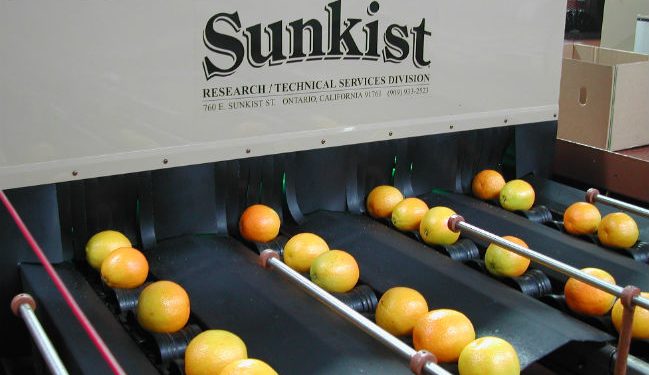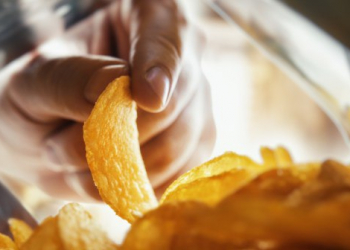Christian Miller feeds thousands of kids a day.
As supervisor for central food production within the Unified School District 259 Wichita Public Schools in Kansas, he oversees a kitchen that provides meals to 63 of the district’s 100 schools. Included in that menu are orange slices, one day a week. That’s 110 cases – by his estimate, about 110,000 each week.
At one time, that meant eight people spending eight hours each slicing oranges. No more. About three years ago, that changed when the department brought in Sunkist Growers’ Auto-90 Commercial Sectionizer. Capable of cutting about 90 pieces of fruit per minute into sections, it’s one of three sizes of Sectionizers Sunkist Growers’ Research and Technical Services offers out of its foodservice division.
Sell more oranges
Close to 120 years ago, Sunkist Growers began its expansion from a co-op of citrus growers who had come together to sell their produce for processing to developing equipment that at its core is designed to help sell more oranges.
“From 1893 to around 1917 or so, that’s when Sunkist decided, ‘Hey, if we can start making some products, like a juicer, or later on a Sectionizer – if we start making and marketing products – this would go a long way in helping to sell more of our produce,” said Tom Cohn, sales and marketing manager for Research and Technical Services’ foodservice division. “The RTS folks, we are basically the support. We were created and developed internally by Sunkist to maximize sales of citrus crops each year.
“As a result of that, the outgrowth of this ancillary division has grown over the years and we’re pretty much standalone at this point in time because of the fact that we have a modest but full line of products and we continue to do research and develop more products.”
It started with the packing house, with Sunkist researchers designing processes, systems and equipment.
“The Sunkist Research and Technical Service Division was mainly a research arm for Sunkist’s grower membership,” said Alex Paradiang, interim general manager. “Its mission was to research and provide packinghouse equipment automation to (give) the membership a competitive advantage.”
After World War II, Sunkist hired its first electromechanical engineer to innovate fresh fruit handling.
“This is the time that we started to phase out wooden boxes in replacement of corrugated cartons,” Paradiang said. “This developed more into packing house improvement wherein a new era of automation began.”
Today, the company’s “Big Equipment” division, as they call it, offers a line of grading, sorting and packing equipment that is used worldwide.
“Everything was developed for our own internal use, again, to assist us in better marketing the produce – which is, quite honestly, the nuts and the bolts of our whole company,” Cohn said.
So it was natural for the company to venture into foodservice. Those flagship products include a commercial juicer that was first patented in 1918, and the Johnny- come-lately Sectionizers, which grew out of a product the company rolled out in the 1940s.
All of the RTS operations and its 25 to 30 employees are housed in a 75,000-square-foot facility in Fontana, California, that includes space for manufacturing, offices and inventory. That’s about 80 miles from Sunkist corporate offices in north Los Angeles.

First came juice
Sunkist began manufacturing its commercial juicer as it appears today in 1973. It comes in two different sizes, though both are tabletops.
“The Commercial Juicer is our original product and is larger than our Pro Series Juicer,” Cohn said. “Both are citrus juicers (and) perform similarly. However, their respective outputs (gallons per hour) vary.”
In general, the company said an operator can extract between 10 and 12 gallons of juice per hour using pre-cut fruit. Juicers come with three extracting bulbs: one each for orange, lemon/lime and grapefruit.
“Sunkist juicers enjoy virtually worldwide distribution with dominance in many countries,” said Cohn, adding that customers include restaurants, bars, night clubs, hotels, amusement parks and hospitals.
Cohn sees niches for expanding juicing technology beyond citrus.
“There’s opportunities for us to expand into the health and nutrition craze, which is just beyond making citrus juicers, so we’re looking into that,” he said. “We’re also looking into automated juicers – juicers that will automatically juice an orange or a lemon, which takes a lot of the labor costs out of the restaurant.
“They’ve been in existence for many years in Western Europe. That kind of craze is very much coming to the U.S. and other countries, and it would make sense for us to be on that bandwagon.”
One wedge at at time
When the company launched its Sectionizer technology, the idea was to take an orange or lemon and section it into perfectly cut wedges of varying sizes.
“Then the idea grew that maybe we could make the machine more versatile by doing more than just citrus,” Cohn said. “We determined that the product was strong enough to do vegetables, too, as long as it doesn’t have a great big seed or pit like an avocado. But basic fruits and vegetables, it would cut. So we started manufacturing and designing additional blade sets so people could slice and cut more product – and just have the unit be more versatile.”

Sunkist’s commercial Sectionizer in its current form was patented in 1974 and comes in three sizes: a junior model that sells for $99 and is intended for small restaurants or bars with low- volume needs; a larger model designed for higher production – say, a large restaurant or group of restaurants; and the Auto 90, designed for high-volume operations like Miller’s in Wichita, which Cohn describes as “a Sectionizer on steroids.” Some central production food processers use it to slice items such as apples that then get bagged and sent to customers like McDonald’s, Cohn said.
“It’s just a gigantic Sectionizer for much, much higher volume,” he said.
Nine different blade sets make it possible to cut apples, pears, kiwi, strawberries, tomatoes, mushrooms – even hardboiled eggs.
“We’ve built the whole concept off a modular theme,” Cohn said. “The blade sets in the Junior are the same as in the Sectionizer and the same as in the Auto 90. Everything is interchangeable, so if they start out with the Sectionizer Junior, and find out their volume needs are greater, they can buy an empty Sectionizer – or if their needs are much larger, they can buy an Auto 90 (and use the same blades).”
Chef Cyndie Story is owner of Culinary Solution Centers in Kentucky. As a consultant to K-12 food operations around the country, she recommends the tabletop Commercial Sectionizer for all of her school kitchens – especially now that providing fresh fruits and vegetables is such an integral part of school nutrition programs.
While she suggests fresh-cut product for some items and operations, she prefers that staff cut the fruit fresh when there is sufficient labor.
“It’s one of the most valuable pieces of small equipment in a quantity kitchen,” she said. “It’s a lot less time to use that piece of equipment versus dong it the old-fashioned way with a knife and cutting board.
“The moment I show it to someone who hasn’t seen it before, they say, ‘I want it.’ It sells itself.”













